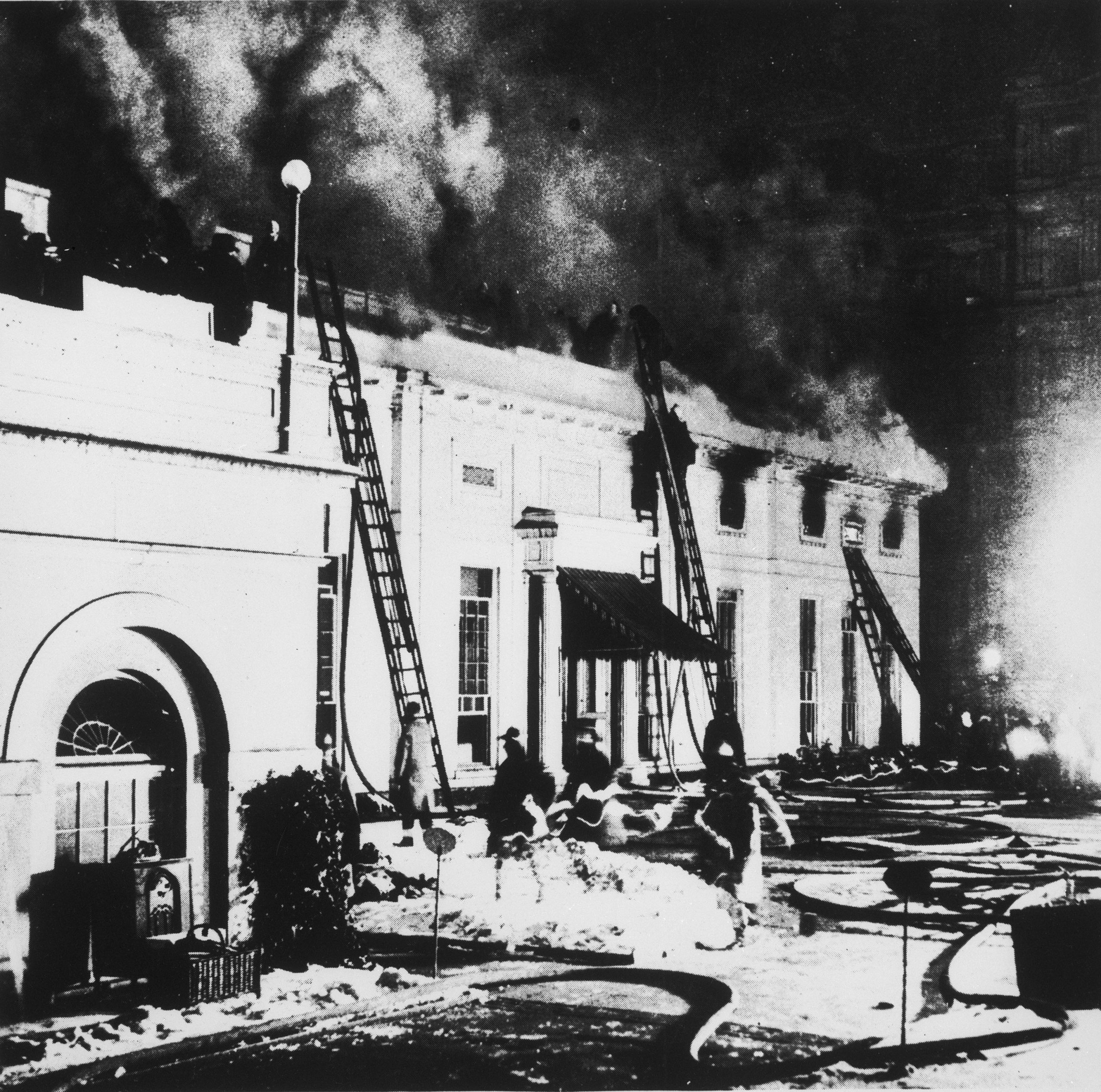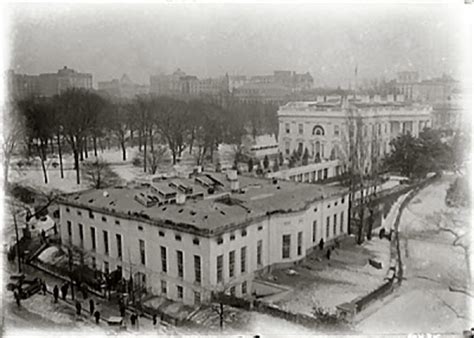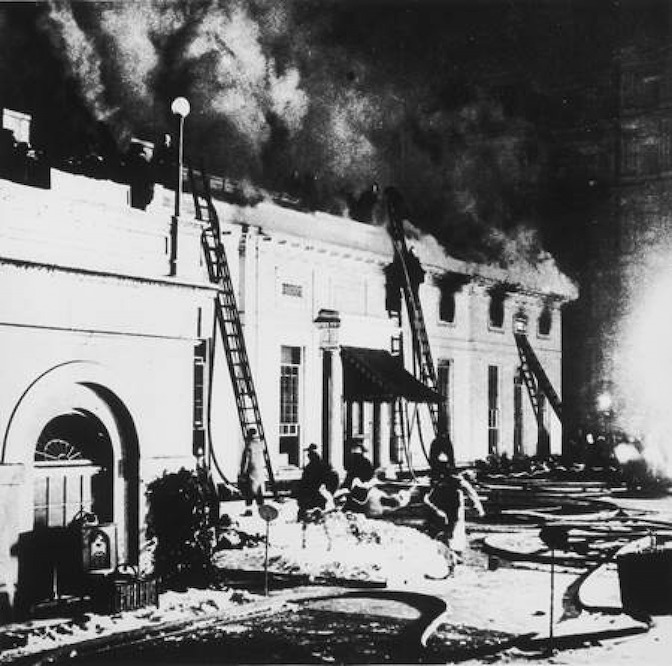The instant Officer Richard Trice pulled the hook of Gamewell Fire Alarm Number 157 remarkable things began to happen. Blocks away, the precinct fire station’s telegrapher heard the chime, noted its identifying code, and shouted, “Fire at the White House!” Nobody paused in shock at the news or stopped to ponder its importance. Instead and within seconds, every fire station in the District of Columbia had their brass gongs sounding with the alert that 157 was reporting a fire. Less than a half-minute later, Captain Edward O’ Connor and his crew were racing toward the White House on Engine 1, a beautiful piece of equipment always kept pristine and polished shiny. It boasted a state-of-the-art 1927 Seagrave Pumper.
As Engine 1 barreled through the front gates of the White House grounds, only five minutes had passed since the alarm from Box 157. But O’Connor saw flames through the attic windows of the West Wing and had a sinking feeling that they were too late. His crew moved with extra urgency to unroll the pumper’s hose to the front door of the Executive Offices where Central Battalion Chief C. W Gill and Rescue Squad 1 grappled with the hose and rushed up the stairs toward the building’s attic. Rescue squads were specialized units equipped with “smoke helmets,” meaning respirators, something Gill had immediately judged necessary because smoke was boiling everywhere. But halfway up the stairs, Gill heard a firefighter’s most dreaded sound: a dull, bass thud followed by a wall of superheated, flaming air moving at gale force. The backdraft knocked every man down the stairs to the main floor. It was remarkable nobody was killed. It was, even more, a miracle that nobody was hurt.
All this had taken only an additional five minutes, and at least Gill now had an idea of what they were dealing with. He immediately escalated the event to two-alarm status. More equipment and men would be summoned, including Truck Companies, the term for hook-and-ladder units. Meanwhile, Gill gathered his men and ordered the pumper to start a full-force flow. Behind the hose nozzle’s wall of water, he and the crew again pushed up the stairs, pausing briefly on each step. God had saved them from the backdraft, but the Devil had thrown it at them, and he was still at work above in the loft, looking for more things to burn.
Everybody might have wondered how it was possible for a fire to break out and go unnoticed in one of the most occupied and vigilantly watched places on earth. The weather and the season accounted for it. Christmas Eve of 1929 was frigid and snowy, which encouraged cheerful hearth fires in the cold and drafty offices of the West Wing. Less than thirty years old, the structure had been built by Theodore Roosevelt’s administration to serve as a temporary office building while a better site was chosen. As they often do, however, one thing had led to another until inertia made the provisional building a permanent fixture. Subsequent administrations tried to repair flaws and renovate oversights, but the place was infamously inhospitable and, as staffs grew, cramped.
Herbert Hoover had tried to do something about that in the spring and summer of 1929. He had just assumed office when he ordered the floor plan revamped to accommodate his large staff and provide offices for his three private secretaries. It was the first significant change to the building in twenty years, and Hoover reveled in the doing of it. He was a detail man by temperament and training, and the construction work on the West Wing appealed to his engineer’s soul and his planner’s imagination. Proper attention to detail could achieve anything in Herbert Hoover’s world where one tackled problems with checklists and solved them against deadlines. He had done such work in the mines of Australia and China, had fed the world during the First World War, and as Calvin Coolidge’s secretary of commerce had tugged the United States into technological modernity by promoting the new-fangled radio and encouraging the expansion of the telephonic network.

So in the West Wing, workmen moved walls while doors disappeared and partitions sprung up. Spaces had been enlarged or diminished on a strict schedule that drove everyone but Herbert Hoover to distraction. By fall, it was done, and done on time, but in truth, it was only marginally better. It could have been a metaphor for Hoover’s presidency.
He had an unprecedented run of bad luck early. Heralded as the prince of prosperity for his detailed checklists and wonderful schedules, Hoover happened to be president when the stock market crashed in October 1929 sending financial indicators trending sharply downward. Going into the Christmas season under such a cloud was sobering, but to have his “new” West Wing burn down would have given a lesser man pause.
Long-time Hoover aide and secretary George Akerson might have caused the fire, for he left a fire burning in his office fireplace when everyone called it a day earlier than usual that Christmas Eve. President Hoover had to light the community Christmas tree and then prepare for a Christmas Eve celebration in the State Dining Room for his staff and their families, especially their children.
But as everyone else was leaving, Akerson hung back because he had a small problem. That afternoon he had picked up his son’s Christmas present, a puppy that had to be hidden during the party. Ackerson decided to park the tiny wire-haired terrier — button eyes, wet black nose, and tail just a’going — in his office. The little fellow was confined to a cardboard box to prevent accidents on the new floors, and Akerson might have put an extra log on the fire to warm the room. It was Akerson’s fireplace that a couple of hours later either caused a chimney fire or overheated the flue to set the wall ablaze whence the flames reached the attic. There a bonanza of combustibles lay waiting, by some accounts a copy of every government pamphlet published since Theodore Roosevelt had been president. These caught fire about 8:00 PM. On the main floor of the West Wing, messenger Charlie Williamson immediately smelled the smoke. At the same time, M. M. Rice working the switchboard in the basement communication room saw wisps of it.
Williamson ran for help. Rice rang up the secret service and then Chief Usher Ike Hoover’s office. Williamson met Secret Service agent Russell Wood and the Metropolitan police officer assigned to the White House, Richard Trice, as they were heading toward the West Wing. Agent Wood climbed the stairs and opened the door on the inferno. Officer Trice sprinted to Fire Alarm Box 157.

As the crew of Engine 1 roared toward the White House, in the East Wing Chief Usher Irwin “Ike” Hoover calmly walked into the State Dining Room where everyone had just been seated for dinner. Hoover, no relation to the president (and glad of it), was an imposing man whose title belied his duties and authority, both extensive. He first came to the White House as a young electrician to install wiring during the Benjamin Harrison administration but stayed after finishing the job because the Harrison family was fearful of electrocution and refused to touch the light switches. From that modest beginning in the 1880s, Ike Hoover over the years evolved into the principal factotum of the place, directing its daily operations as presidents came and went, most of whom he liked and some more than others.

He didn’t like Herbert Hoover from the start. He thought the president was a “peculiar” cold fish who always wore “a frown on his face and a look of worry.” The President was never unpleasant but at best was distantly cordial. It never occurred to Ike Hoover why he didn’t like the president. The chief usher could have been describing himself.
In the State Dining room, Ike Hoover was whispering the news to Larry Richie, Hoover’s principal secretary, when the president leaned in and heard the chief usher say, “The executive offices are on fire. I want to take the secretaries away from the table.” President Hoover said quietly, “I’ll go, too!”
An active fire with engines deploying crews on the grounds? Herbert Hoover would not have missed it for the world. He led the small group of secretaries and aides across the length of the house to the West Wing. Along with the official family were his son Allan, down from Harvard for the Holidays, and young Walt Newton, the son of another of Hoover’s secretaries. Newton, who had started at the Naval Academy that fall, was proudly sporting his sharp Midshipman’s uniform for the girls at the party, but this adventure promised to be more exciting.
As it was. The president with his three companions gained access to his office through a window, and finding the smoke had not yet thickened, began tossing papers and artifacts out of it into the snow. Hoover helped to pull drawers out of his massive desk and heave them and their contents outside, at least until frowning Secret Service agents swarmed in, put a stop to it, and told them all to scram. The boys went out to sort through the memorabilia and papers, and Hoover grudgingly agreed to leave as well, but not before pulling aside an agent and giving him some emphatic instructions.
By the time Herbert Hoover had made his way to the roof of the Conservatory — the part of the White House that bridged the West Wing and the main mansion — it was clear he was in for quite a show. Below him, firemen swarmed amid equipment and engines. Trucks were arriving to fit among those parked. Brilliant calcium floodlights set up on the perimeter of the grounds illuminated everything. To anyone else, it would have looked like ants in a chaotic frenzy, running willy-nilly to no purpose, but Hoover could tell he it was a remarkable display of precise cooperation, division of labor, and flawless execution.
George S. Watson, the chief engineer of the fire department, had weaved through traffic without benefit of a siren — he was in his own car — speeding for thirty-five blocks from his home through red lights and roundabouts to reach the White House in less than ten minutes. He had instantly raised the event to three-alarm status to bring in additional hook-and-ladders and had then directed the placement and operations of the new equipment and men as they arrived. President Hoover was consequently treated to a complex ballet choreographed on the fly in which not a single dancer missed a step.
Indeed, only one snag briefly impeded the response. Chief Engineer Watson, a detail man after Hoover’s own heart, had made sure that the captains of all units designated as first-in responders have keys to any and all locks. Yet, as engines idled at the locked and barred south gates of the White House grounds the captains’ keys wouldn’t work. A few minutes later, panting policemen arrived from inside the grounds to unlock the gates, and later it was discovered that the Secret Service had changed the locks but had neglected to supply the fire department with new keys. It was the kind of overlooked detail that exasperated the president, and the agents responsible could only hope that Hoover had not noticed the delay it had caused. He did. Even people who knew him well sometimes forgot that Herbert Hoover noticed everything.
But as miracles accumulated that Christmas Eve, it didn’t matter.
At the communications switchboard in the basement, Rice remained throughout the event pulling and inserting plugs in his switchboard despite the water from the pumpers gathering at his feet and rising to his knees. He could have been electrocuted but wasn’t.
On the main floor, Ike Hoover despaired over the massive table in the Cabinet Room being destroyed by the falling joists and cascading water. His desperate search for something to protect it seemed hopeless, but he discovered an enormous tarpaulin large enough to cover the table completely. It was in the first place he looked.
Six firefighters in the president’s office trying to save things were floored when the weight of the water above collapsed the ceiling. Four were completely unscathed, and the two who suffered minor injuries were struck just glancingly by a falling chandelier, which could have killed them, but didn’t. In fact, nobody was seriously injured, and only a half dozen firefighters suffered a bit of wooziness from smoke inhalation.

Ultimately the fire department raised the event to a five-alarm fire, which mobilized every person on staff, bringing additional equipment to bear on the West Wing while activating reserve material and men to handle incidents elsewhere in the city. By 1:00 AM on Christmas morning, the firefighters had won, and the blaze was out. The West Wing was a smoldering wreck.
Nevertheless, it was in excellent shape compared to George Akerson, who knew in his broken heart that the puppy he had left in his office was dead.
Akerson had been delegated in the new administration as the exclusive liaison with the press, an innovation that had him establishing the new office of press secretary. When he left the table in the State Dining Room, his mind was racing as he contemplated the information cyclone the fire would cause. Then at the West Wing, he was caught up in the efforts to save paperwork and files on the south side of the building where the president and his chief aides worked. The north side of the building, where Akerson’s office was, suffered the greatest damage because of that priority. Not until the fire was out and fire crews were packing up gear did Akerson remember the puppy left alone in an office that was now gutted and gone.
He felt sick to his stomach and barely noticed the fireman approaching him with a cardboard box. It was a miracle, he marveled, that they had run across the puppy. Not really, said the grinning fireman. Somebody had told the Secret Service exactly where to find him and who he belonged to.
George Akerson looked down at the little terrier with his button eyes, wet black nose, and tail just a’going. He couldn’t believe it, and in a daze he ran the fireman’s words through his mind: Someone told the Secret Service.
Herbert Hoover was a detail man.

